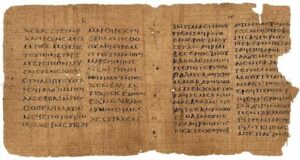Have archaeologists discovered the earliest mentions of Jesus which were buried by a famous volcano?
Mount Vesuvius was responsible for the destruction of the Pompeii and Herculaneum on August 24, 79 AD and is without a doubt the most famous volcanic eruption in history, even though not the deadliest one, as many people falsely tend to believe. Still, scientists have estimated that Mt. Vesuvius released thermal energy 100,000 times more powerful than the atomic bombs over Hiroshima and Nagasaki during World War II. For the record, before the eruption of Vesuvius, there was no word for volcano. They had to come up with one right after the catastrophic eruption. The word is derived from “Vulcan,” the Roman God of Fire.
Charred scrolls from the ruins of the city of Herculaneum may contain early Christian writings. Although Herculaneum has been known to have an extensive library of ancient documents, they have not been researched due to becoming extremely brittle after exposure to volcanic heat.
However, a group of scholars including Brent Seales of the University of Kentucky, hope to use modern medical imaging technology to analyze the text of the fragile scrolls. The technology has been successfully used to read other materials including Dead Sea scrolls.
“People were going to the doctor every day. And they were doing a CT scan or an MRI. And they were seeing inside their body completely non-invasively. If you can do that to a human in the doctor’s office, why couldn’t we see inside a scroll? That was the thinking,” explained Seales on the Sunday edition of CBS’ “60 Minutes.”
 “The people are gone. The cultures are gone. The places are gone. And yet, like a time capsule, you have this item that tells a story.”
“The people are gone. The cultures are gone. The places are gone. And yet, like a time capsule, you have this item that tells a story.”
“60 Minutes” reported that scholars believe that the ancient documents found at Herculaneum may include “early Christian writings, even the first references to Jesus.”
There has been much debate over whether Pompeii and Herculaneum, whose destruction has been the subject of novels, documentaries, and movies, had Christian populations.
Mt. Vesuvius erupted and destroyed the Roman cities just nine years after Roman troops destroyed Jerusalem after a Jewish revolt. It is estimated that in that invasion 700,000 Christian and Jewish inhabitants of Jerusalem were murdered and those that fled would have been dispersed across the Roman empire–including Herculaneum and Pompei.
While archaeologists believe they have located homes from both ruined cities that had crosses on display, one scholar disputes it. John Granger Cook says a thesis laying out the evidence is too weak.
“The thesis that CIL 4, 10062 and two cruciform artifacts in Herculaneum and Pompeii are Christian crosses, which indicate a pre-Vesuvian Christian presence in Campania, cannot be sustained,” read the abstract of a 2018 article by Cook.
Ancient scrolls are not the only thing recently discovered. The sites continue to yield fascinating finds that give a look into the culture of the time. One recent find was a group of individuals huddled in a building as they tried to escape the ash outside. In the group of skeletons recently unearthed are two pregnant women with their unborn babies still in the womb.
 Metro Voice News Celebrating Faith, Family & Community
Metro Voice News Celebrating Faith, Family & Community 







